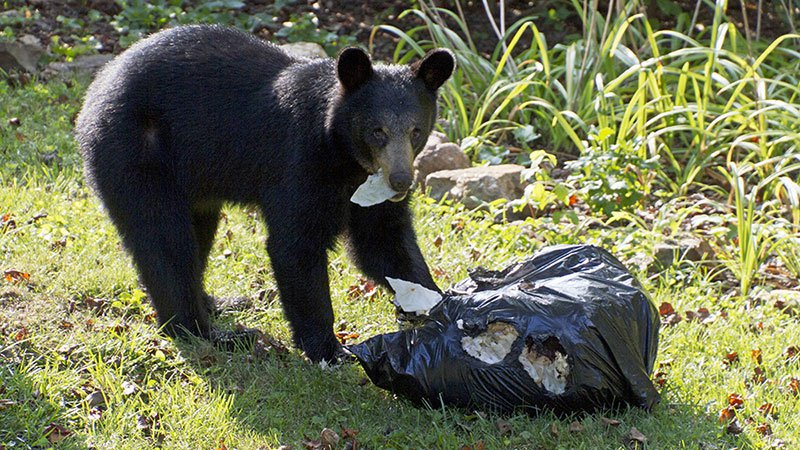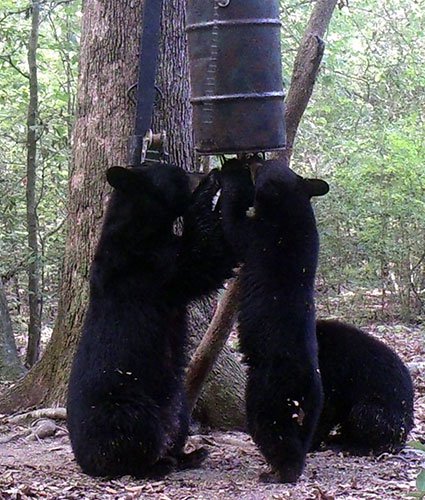Late summer means trouble bruins
ON 08-05-2020

Aug. 5, 2020
Randy Zellers
Assistant Chief of Communications

FAYETTEVILLE — Arkansas’s bear population has made the news on more than one occasion in the last few weeks. Arkansas Game and Fish Biologists have had to relocate some black bears from a few towns in The Natural State recently, with one even taking a stroll on the University of Arkansas’s campus. The uptick in sightings is fairly common for this time of the year, but there are a few things people can do to help keep these wild animals in the woods and out of trouble.
“Food is what they’re after at this time of year,” said Myron Means, large carnivore program coordinator for the AGFC. “We received calls for 53 nuisance bear cases in July, and that’s a pretty typical count for this time of year.”
Means says the reason for the rise in nuisance calls during mid- to late summer revolves around wild food sources beginning to dry up.
“The blackberries, dewberries, blueberries and other soft mast that bears prefer are just about gone this time of year and it will be a little while before elderberries, pokeberries and other soft mast comes on,” Means said. “In a month or so, we’ll start to see some hickories, beechnuts and acorns come into play, but this is usually a time when food supplies are getting thinner and bears are having to work a little harder to find them.”
That search can sometimes land bears in people’s backyards, where they find an easy meal and become a nuisance. According to Means, 90 percent of the calls received by the AGFC about nuisance bears stem from the bears finding food in the form of unsecured trash cans, loose pet food and bird feeders. And the problem can be solved quickly with the removal or securing of those attractants. As part of the AGFC’s nuisance protocol, biologists won’t remove a bear that is being fed, either intentionally or unintentionally, through human means.
“We just don’t have the staff or equipment to respond to a dozen calls a day, which is how many we can receive in a bad year,” Means said. “We had so many calls that were about bears where people were feeding wildlife that we had to change our protocol to have all food removed before we would relocate a bear. And it doesn’t matter how far we remove that bear if it’s an adult, they can instinctively find their way back to their home range and be right back on that food source if the root of the problem isn’t corrected.”
Out of the 53 nuisance cases in July, only four required a relocation and all were because of public safety concerns from the bears wandering into towns. The other 49 cases were resolved by the landowner simply removing the food source and letting the bear go about its business.
“Once a bear goes to that easy food source and finds it empty a few times, they will go elsewhere to get a meal,” Means said. “But if people leave food out or intentionally feed the bears, that’s when we get into nuisance problems. Most people do not realize that it is actually illegal to feed bears in Arkansas except during a bear hunting season and 30 days prior.
Means explains that bears can become habituated to finding the free meal and often it’s the result of someone thinking they need to help the bear or keep it around for pictures and entertainment. Once that bear begins to lose its fear of people, it can become more aggressive or damage property seeking more food. With no negative response at bad behavior, the bear doesn’t know any better than to continue seeking food and pushing its way around.
“That’s not good for people, and removing it isn’t good for the bear,” Means said. “It’s best to simply stop the feeding and make sure the bear gets the hint that it’s not welcome from the beginning.”
Means and other biologists from throughout the Southeast have worked together to help people learn more about bears and how to live in areas where bears may be present. Together, they formed a special website to deliver bear safety tips and information. Visit www.bearwise.org to learn more.
Recent News
Subscribe to Our Weekly Newsletter E-mails
Don’t miss another issue. Sign up now to receive the AGFC Wildlife Weekly Newsletter in your mailbox every Wednesday afternoon (Waterfowl Reports are published weekly during waterfowl season and periodically outside the season). Fishing Reports arrive on Thursdays. Fill in the following fields and hit submit. Thanks, and welcome!


